Contour farming is a way to use the contour of the land to reduce irrigation and erosion and maximize nutrient uptake for abundant crop production. It is a popular tool in permaculture gardens. Contour farming is tilling sloping land along continuous elevation lines to conserve rainwater and reduce soil losses from surface erosion. These goals are achieved through slopes, crop rows, and wheel tracks on slopes, all of which act as reservoirs to capture and retain rainwater, thereby increasing infiltration and more uniform water distribution.
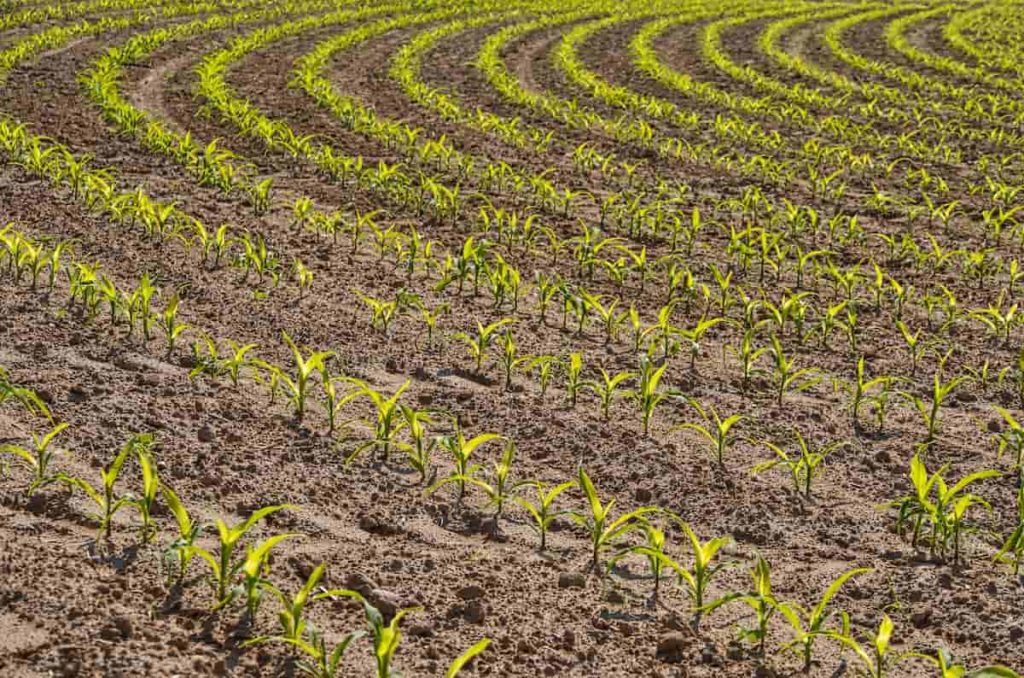
Contour farming guide
What is contour farming?
One of the earliest methods of tillage conservation is called contour plowing or contour agriculture. A piece of farmland with a gentle slope prevents soil from being carried downhill by a rainwater runoff rather than an up-and-down gradient.
Contour farming (contour farming, contour tillage, or contour bunding) is a discipline that is good for growing food in the mountains. When farmers carry out their agricultural activities (ploughing, planting, growing, and harvesting) across the hill instead of up and down the slope, they are with contour farming. It is a very old outline of farming. Agriculturalists around the world use recycling and yield conservation practices.
It is a sustainable method of farming where farmers plant crops across or perpendicular to the slopes according to the shape of the slope. This plant arrangement disrupts water flow and makes soil erosion more difficult.
Benefits of contour farming and the best way to start
- This practice has been shown to reduce fertilizer loss, power and time consumption, and wear on equipment, increase crop yields and reduce erosion.
- It can help absorb the impact of heavy rains, which often wash away topsoil in straight-line plantings. Contour farming is most successful with practices such as strip cropping, terracing, and water diversion. This method is also known to prevent tillage erosion. Tillage erosion is the movement and erosion of soil by plowing a given plot of land. A similar practice is contour farming, where stones are placed around the shape of slopes.
- Contour plowing helps reduce soil erosion. This process has been proven to reduce fertilizer loss, power and time consumption, wear on machines, increase crop yields and reduce erosion. Contour farming can help absorb the effects of heavy rains, which often wash away topsoil in straight-line plantings. Contour farming is most effective in conjunction with strip cropping, terracing, and water diversion practices.
- Contour farming helped combat soil erosion and is believed to reduce it by 50%. Traditional farming involves cultivation on long, steep slopes parallel to rainwater. This method allows rainfall to easily wash away topsoil, which is important for growing crops. Contour farming in India helps reduce runoff and gives time for the water to absorb properly into the soil.
- Contour farming provides efficient soil irrigation. Contour farming or contour planting helps distribute water in the soil evenly between furrows as water moves slowly and efficiently. As the irrigation water penetrates the furrows quite slowly but deeply, it greatly improves water absorption in the soil. Unlike the downslope irrigation method, which drains the water channels quite quickly, making it difficult for the soil to absorb water. Contour farming in India requires less labor to maintain the irrigation system than the traditional downslope irrigation method. It helps in saving labor costs to a great extent.
- There are various ways in which contour farming reduces the cost of crop production. One of them is the conservation of soil fertility. Because contour cropping reduces fertility loss through erosion and leaching, it reduces the need for fertilizer application. Reduced demand for fertilizer means reduced production costs. Contour farming also reduces crop production costs by conserving crop species and water resources. It reduces the cost of these measures and the need for new seeds and irrigation. Finally, contour farming eliminates the need and cost of soil rehabilitation by conserving land resources and reducing the risk of degradation.
- Contour farming leads to improved regional water quality as it reduces the impurities that are transported by runoff into the water body. By reducing erosion and leaching, stormwater fouling and sediment loads are reduced. When this water enters rivers, aquifers, or underground aquifers, it does not cause degradation. Chemical pollution and eutrophication resulting from manure runoff are also reduced.
Ideal places and conditions for contour farming
Contour farming is not optimal for all slopes and climates. Contour farming is successful on slopes with gradients between 2% and 10%. Secondly, within a given period, the region must receive a certain amount of rainfall. In contour farming, strip-chopping becomes suitable when the slope is steep, and rainfall is high, as it offers an additional layer of security.
Experts advise contour farmers to use additional soil and water conservation methods to get the best results. These supplements include, among others, strip planting, use of cover crops, windbreaks, weeding waterways, and construction of terraces. Strip cropping is good for long and steep slopes, while irregular slopes require more than one main contour line.
Farmers can use a contour gauge or hand level while receiving the key line and then plant parallel to the key line. Grassed waterways are also important, especially where runoff is highly concentrated, while grass strips are useful where contour lines are too sharp for plowing farming equipment. Growing shrub or tree borders across slopes (vegetative barriers), residue control, and mulching are other strategies that should be used to protect the soil.
In case you missed it: A Guide to Understanding Irrigation Management: Check How this Helps Farmers
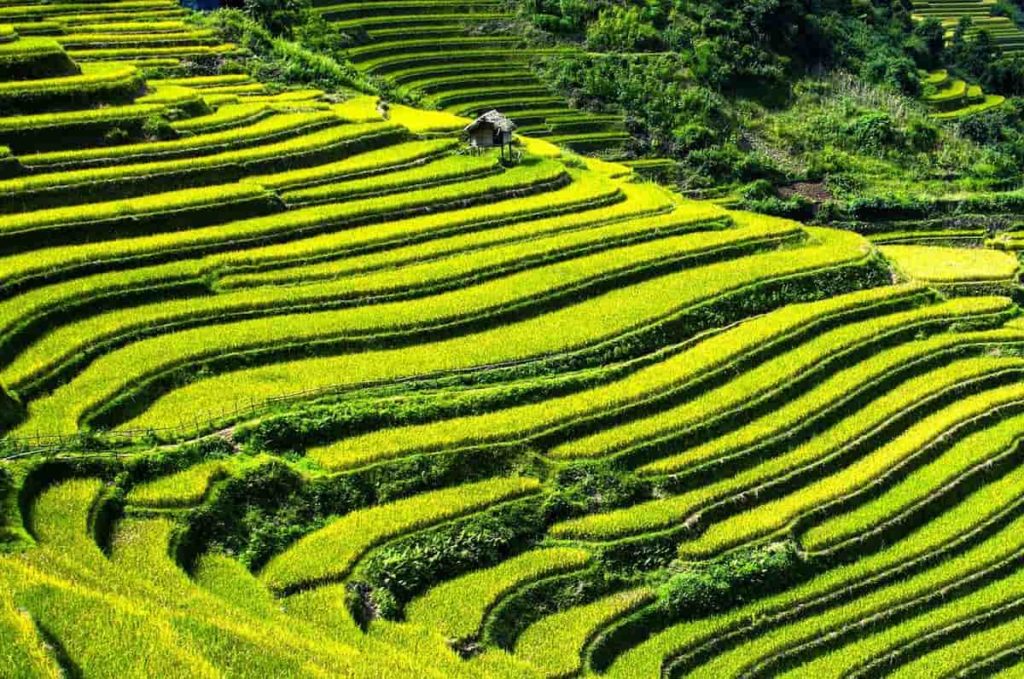
Assam and Meghalaya are places where contour farming is practiced extensively, given the geographical background and abundant rainfall. Hence, Assam is an ideal state for contour farming. The practice of contour farming, although good, is not ideal on all slopes and climatic conditions. Contour farming is effective on slopes with gradients between 2% and 10%. Secondly, the area must receive a certain amount of rainfall in a certain period. When slopes are steep, and rainfall is high, strip cutting becomes ideal in contour farming as it provides an extra layer of protection.
Process of contour farming
Contour farming is the process of first leveling contoured areas or hills by farmers using a contour plough. As a result, the hill where crops are grown has a set of steps. To prevent water from flowing downward, breakwater or raised platforms—are built around the edges of these steps. This water breaks down to help keep the water on the surface of separate steps, giving the ground more time to absorb the water.
It is a farming process with row patterns that run roughly level around the hill rather than up and down it. Generally, as soon as it rains, there is a lot of runoff which usually leads to soil erosion in the downstream direction. It removes the fertile topsoil, soil nutrients, and plant seeds, thus causing low and uneven crop growth. To avoid this, this simple farming practice is carried out across the slope, so there is no steep slope in the field.
The ridges and furrows thus formed act as a continuous barrier to the free movement of water downstream, thereby allowing more time for infiltration. Therefore, soil removal with nutrients is highly investigated to increase soil fertility and crop yield. Contour farming is the practice of plowing horizontally along the contour of the land. This plowing technique prevents soil erosion by capturing water flow in hilly and contoured areas.
Contour lines also create water retention that reduces the formation of ruts and gullies during heavy rains, allowing water to percolate into the soil. It is a sustainable form of agriculture practiced mostly in hilly and sloping areas. Farmers who practice contour plowing begin by cutting the surface in hilly or contoured areas. It creates a series of steps on the hill on which crops are grown.
Raised platforms, also known as water breaks, are built along the edges of these steps to prevent water from running downhill. These water breaks help keep water at individual levels, giving it more time to be absorbed by the soil. In less steep areas, the land is only plowed horizontally following contours. The process of Contour farming:
- The contour of the land guides the plow.
- It causes an uplift of the land, forming a furrow on the slope.
- Land length and slope gradient determine furrow size.
- On the opposite side of the hill, a ridge is created using excavated soil.
- Repeat this process until the entire field is ploughed.
How does contour farming work?
Contour farming is an efficient and cost-effective modern farming method that aims to help trap irrigation water in such a way that:
- During heavy rainfall, the soil can absorb water evenly.
- Soil can be protected from getting washed away.
- Fertilizers can be prevented from leaching to ensure that crops receive sufficient nutrients and inputs to thrive.
- Contour farming is often used with other methods, such as terraces, water- and sediment-controlled basins, and strip-cropping.
- Long, steep slopes may require strip cropping rather than just contour farming, less effective at preventing excessive erosion on steep or steep slopes.
- Irregular slopes may require more than one key contour line. Some fields may be too steep and irregularly shaped for contour farming.
Plowing and planting in slope contours create man-made water gaps that allow water enough time to penetrate the soil and settle the topsoil without washing down the slope. On slopes with no contours, water runs off quickly without the soil absorbing it properly and taking the fertile topsoil with it, leaving infertile soil on the slope.
Contour farming also creates water breaks that reduce the formation of gullies and ruts when a site experiences heavy rainfall and runoff, which is a major cause of soil erosion. For contour farming to be effective, the resulting curved furrows around the slope must be level. Contour farming can have a single crop on the farm or a mixture of crops through strip cropping.
In case you missed it: A Guide to Understand Biofloc Fish Farming: Check How this Guide Helps Fish Farmers
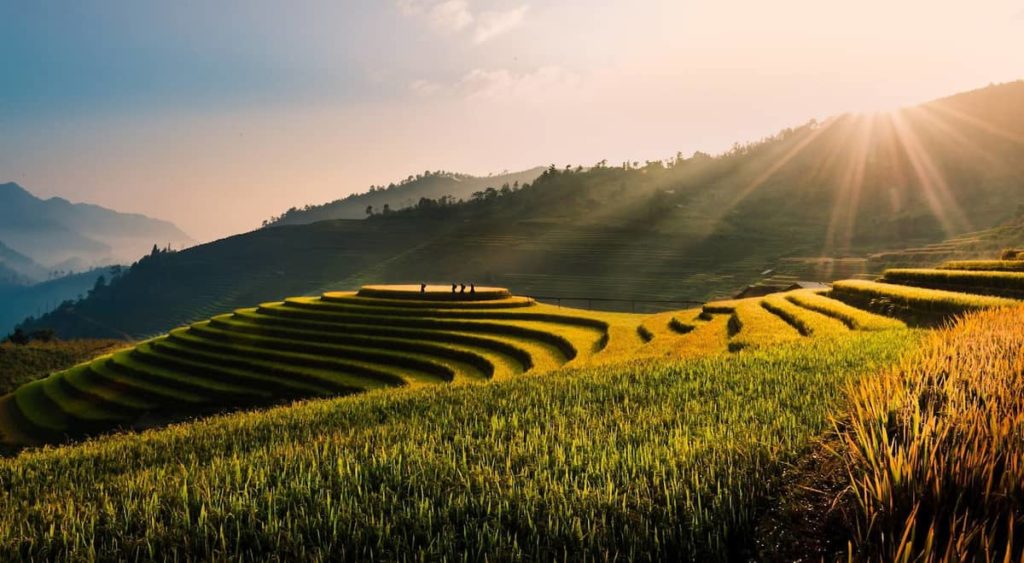
Objectives of Contour farming
The contour farming practice is used to achieve the following objectives.
- To reduce sheet and rill erosion.
- To transport sediment and other solids and reduce nutrients; and
- To increase the infiltration rate.
Contour farming is done on moderately sloping land. When it rains, sheet flow or subsurface flow occurs immediately after the rain (rainfall intensity exceeds the soil infiltration rate) and flows downward with greater velocity. Since the velocity of the flow is high, the kinetic energy of the flowing water is high. Due to this, the soil particles are easily washed away. In this case, in such an area, if farming, plowing, etc., are carried out on the contour of the normal land slope, the built-up ridges obstruct the flowing overland flow.
This effect significantly reduces the velocity of overland flow, which leads to a reduction in soil erosion. In addition, ridges formed on the slope face cause a continuous slope length distribution, which is also very effective in reducing soil erosion. In a nutshell, the effects of contour forming are suitable for preventing sheet and rail erosion. Since the process is followed on the contour of the area, all tillage operations are carried out on the slope’s contour. Therefore, direct obstruction occurs in the flow path of overland flow.
Under this, soil erosion from the inter-ridge area is trapped by the formed ridges, which accumulate near the ridge base. In this way, the objective of contour farming is achieved. Due to the formation of a network of ridges across the slope in the contour farming system, the opportunity time for infiltration is increased, resulting in a significant increase in total soil water content. As the amount or rate of infiltration increases. Therefore, the net amount of water available to generate overland runoff is reduced. It will, in turn, reduce the flowing water’s erosive power; and also reduce soil erosion.
What is strip cropping?
Strip cropping in contour divides a steep land into contour strips that cut the flow path of the soil and restrict its movement. Low-growing soil-conserving crops (e.g., Cowpea, Soybeans, Stylosanthes, Pueraria) are grown in alternating strips with open-row soil-degrading crops example, Maize and Rice. A crop is grown in a contour strip below an erosion slope that encourages the crop to absorb runoff and prevent runoff velocity and sediment.
Strip cropping prevents soil erosion by maintaining natural dams for water, thus preserving soil strength. Strip cropping is a beneficial farming practice that provides additional benefits beyond increased yield. Using strip cropping effectively reduces soil erosion, especially on sloping land. Properly selected neighboring species positively affect each other, thereby increasing the productivity of the field.
However, the benefits of strip cropping also involve some effort, which is easy to implement with smart farming tools. Alternate strips are mainly established on the contour. These strips facilitate the performance of all farm operations on the contour. Contour strip cropping is used in conjunction with contour farming. Crops are arranged so that a strip of grassland or small grains is alternated with a strip of row crops. Crops cannot be planted on more than half of the field area.
Grassland slows runoff, increases water infiltration rates, traps sediment, and provides surface cover. Ridges formed by contoured rows slow water flow and reduce erosion risk. By rotating the strips from corn to legumes, nutrient-demanding crops benefit from the nitrogen added to the soil by the legumes.
In case you missed it: Exotic Vegetable Farming in India: Check How this Growing Guide Helps Beginners
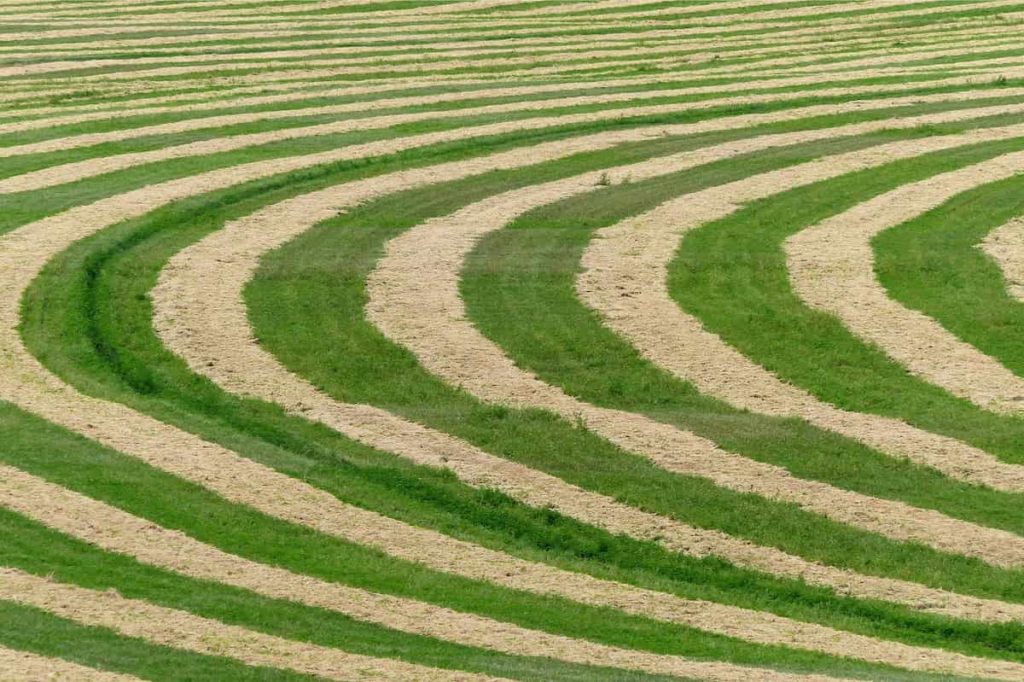
Contour strip cropping combines the beneficial effects of contouring and crop rotation. It can be combined with roofs to provide additional erosion control and stormwater management. Contour strip cultivation is recommended on plain land across a slope, used to prevent runoff (movement of water over the land surface) that reduces soil fertility.
Studies show that combining contour strip cropping with terracing conserves water and soil. The topography of the land determines the size of the belt. Plants are cultivated in strips along the contour at right angles to the direction of the slope of the land. Crops are grown in a rotational arrangement. It ensures that plants are grown in order and cared for throughout the year, with or without rotational planting.
Purpose of the strip cropping
Strip-cropping agriculture improves soil health or promotes primary species’ growth. Secondary species rarely bring additional income to producers but are the cheapest conservation techniques. In particular, strip farming:
- Dealing with wind and water erosion;
- Improves water infiltration;
- Retains soil moisture;
- Reduces yield loss from wind and airborne particles;
- Reduces sedimentation;
- Improves water quality;
- Increases soil fertility;
- Participates in nitrogen fixation;
- Attracts pollinators;
- Controls pests.
Popular crops are grown through contour farming
- Corn
- Soybeans
- Wheat
- Grass
- Legumes
Cover and green manure crops, including Cereal Rye, Oats, Clover, Ryegrass, and Winter Wheat, are grown in fields, orchards, vineyards, and some recreational and wildlife areas. To temporarily protect the land from wind erosion and water erosion. When land is not adequately protected. These crops are usually plowed to accommodate the main crop grown on-site.
In case you missed it: Top and Highest Milk Producing Cattle/Cow Breeds in India: Best Guide for Beginners
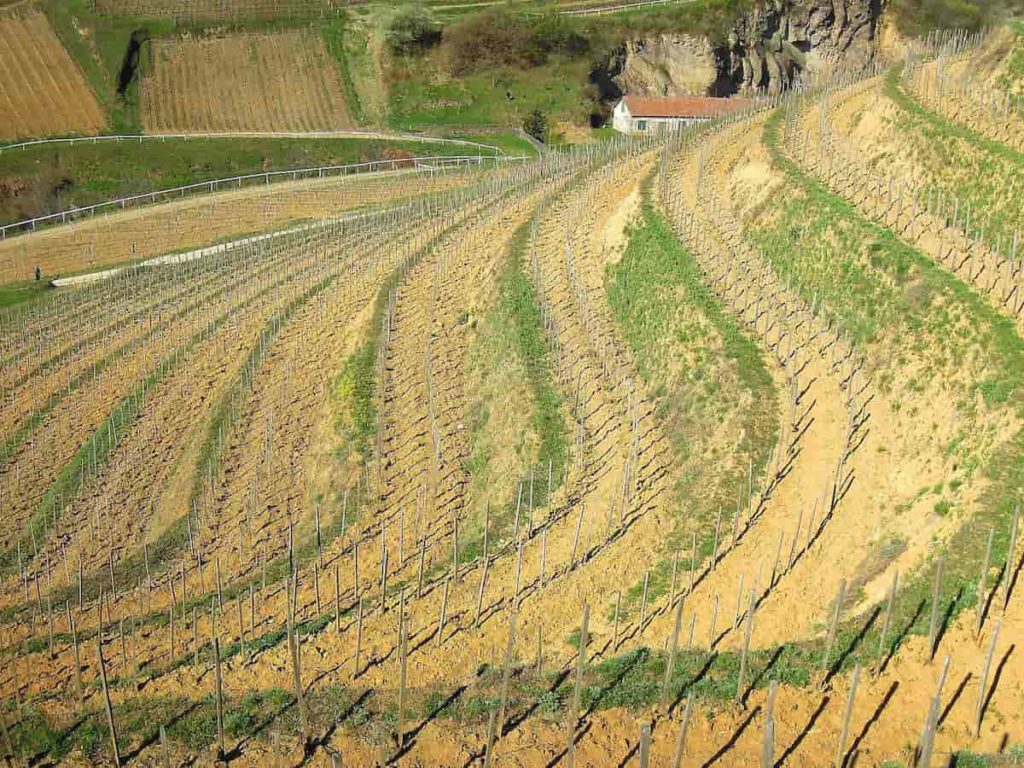
Contour lines in contour farming
The most prominent feature of contour farming is the contour line. It is an imaginary line perpendicular to the slope of the field and corresponds to the row in the check-row pattern of planting. A line or row crosses the field from one boundary across the slope to the opposite side of the slope, i.e., east, west, etc. Depending on the distance from top to bottom and the distance from row to row, many such lines are formed on the face of the slope.
Line-to-line distances may vary with slope. All lines will appear straight when viewed from the opposite face of the slope. However, on a top view, the lines may be either straight, curved like the outside of a sphere, or irregularly curved downwards or upwards, depending on the presence of low and high surfaces on the slope face.
These lines define the placement of perennial crops, hedges, or terraces in contour farming. Theoretically, all points on any single line are assumed to be at the same vertical elevation or height, for example, 400 meters above sea level. As with rice terraces, all walls or dykes must be leveled horizontally, or water will spill on any lower part.
Preparation of land for contour farming
- On sloping fields where crops are grown
- Slope fields with vegetable beds
You must be aware of water movement when you grow crops on slopes. Be extra careful to protect fields from water damage. Plan for a heavy rain before it falls. Long, smooth, even slopes accelerate flowing water. Fast-moving water has great power to cut deep into the earth. It can wash away the soil in your field and damage or destroy your crops. Use conservation practices to reduce the length of slopes, make them more irregular, and reduce stormwater runoff. The following steps must be taken into account to prepare the land or ground surface for contour farming;
- Conduct a typographic survey of the field.
- Create field borders to make room for the movement of farm or tractor equipment.
- Consider carrying out farming activities parallel to the baseline contours.
Disadvantages of contour farming
The disadvantages of contour farming are that it is widely used compared to conventional tillage methods. A significant limitation of contour plowing is its contribution to pockets of uncultivated land. These undisturbed patches eventually develop weeds, which require additional herbicides. Killing weeds sometimes destroys surrounding grass, creating another opportunity for rainwater to run off.
To counter this possibility, contour plowing is often applied in conjunction with other soil conservation techniques, such as terracing. Due to the drawbacks of contour ploughing, it is less widely used than conventional tillage methods. Some farmers may not be fully aware of erosion damage and prevention. Lack of access to funding, equipment, or training sometimes takes their toll.
In case you missed it: How to Start Exotic Fruit Farming in India: A Production and Growing Guide for Beginners
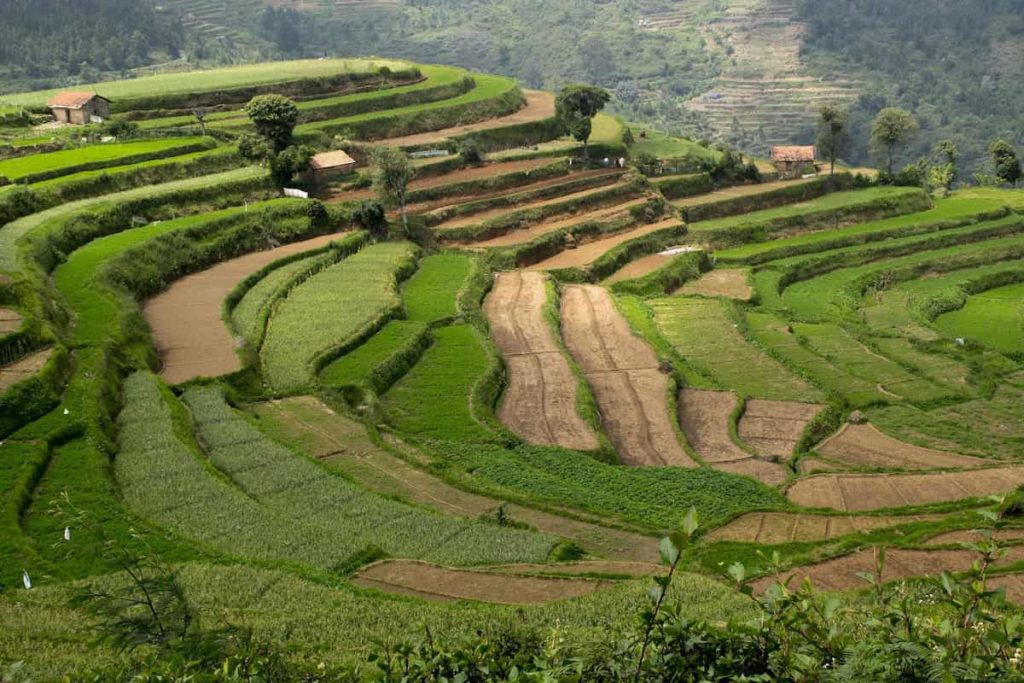
Conclusion
The effectiveness of contour farming decreases with increasing slope gradient and length and increasing rainfall intensity. If rainfall exceeds the surface detention capacity of the contouring system, concentrated runoff downstream can cause rapid erosion and even severe gullying unchecked. So, contour farming alone is not sufficient to control erosion on steep, long slopes, erosive soils, and during erosive rainfall.
The simplest method for controlling erosion is contour farming (e.g., performing all farm operations on a contour rather than up and down a slope or parallel to field boundaries). Important farm operations in contour farming to control soil erosion include ploughing, harvesting, sowing, fertilizer application, and inter-row cultivation.
- Types of Pesticides Used in Agriculture: A Beginner’s Guide
- Economical Aquaculture: A Guide to Low-Budget Fish Farming
- 15 Common Planting Errors That Can Doom Your Fruit Trees
- How to Make Houseplants Bushy: Effective Tips and Ideas
- Innovative Strategies for Boosting Coconut Pollination and Yield
- Pollination Strategies for Maximum Pumpkin Yield
- The Complete Guide to Chicken Fattening: Strategies for Maximum Growth
- Natural Solutions for Tulip Problems: 100% Effective Remedies for Leaf and Bulb-Related Issues
- Revolutionizing Citrus Preservation: Towards a Healthier, Greener Future
- Natural Solutions for Peony Leaf and Flower Problems: 100% Effective Remedies
- Maximizing Profits with Avocado Contract Farming in India: A Comprehensive Guide
- Natural Solutions for Hydrangea Problems: 100% Effective Remedies for Leaf and Flowers
- The Ultimate Guide to Choosing the Perfect Foliage Friend: Bringing Life Indoors
- From Sunlight to Sustainability: 15 Ways to Use Solar Technology in Agriculture
- The Ultimate Guide to Dong Tao Chicken: Exploring from History to Raising
- The Eco-Friendly Makeover: How to Convert Your Unused Swimming Pool into a Fish Pond
- Mastering the Art of Delaware Chicken Farming: Essentials for Healthy Backyard Flocks
- 20 Best Homemade Fertilizers for Money Plant: DIY Recipes and Application Methods
- How to Craft a Comprehensive Free-Range Chicken Farming Business Plan
- Brighten Your Flock: Raising Easter Egger Chickens for Beauty and Bounty
- How to Optimize Your Poultry Egg Farm Business Plan with These Strategies
- Subsidy for Spirulina Cultivation: How Indian Government Schemes Encouraging Spirulina Farmers
- Ultimate Guide to Raising Dominique Chickens: Breeding, Feeding, Egg-Production, and Care
- Mastering the Art of Raising Jersey Giant Chickens: Care, Feeding, and More
- Ultimate Guide to Raising Legbar Chickens: Breeding, Farming Practices, Diet, Egg-Production
- How to Raise Welsummer Chickens: A Comprehensive Guide for Beginners
- How to Protect Indoor Plants in Winter: A Comprehensive Guide
- Ultimate Guide to Grow Bag Gardening: Tips, Tricks, and Planting Ideas for Urban Gardeners
- Guide to Lotus Cultivation: How to Propagate, Plant, Grow, Care, Cost, and Profit
- Agriculture Drone Subsidy Scheme: Government Kisan Subsidy, License, and How to Apply Online
- Ultimate Guide to Raising Araucana Chickens: Breed Profile, Farming Economics, Diet, and Care
- Bringing Hydroponics to Classroom: Importance, Benefits of Learning for School Students
- Ultimate Guide to Raising Polish Chickens: Breed Profile, Farming Economics, Diet, and Care
- Ultimate Guide to Raising Australorp Chickens: Profile, Farming Economics, Egg Production, Diet, and Care
- Silkie Chicken Farming: Raising Practices, Varieties, Egg Production, Diet, and Care
- Sussex Chicken Farming: Raising Practices, Varieties, Egg Production, Diet and Care
Excellent!
This is very informative and very applicable to farming in sloping areas like in the Philippines. Thank you and God Bless!